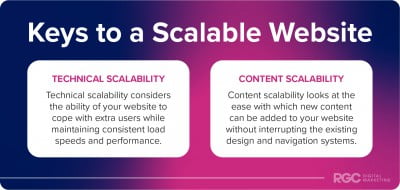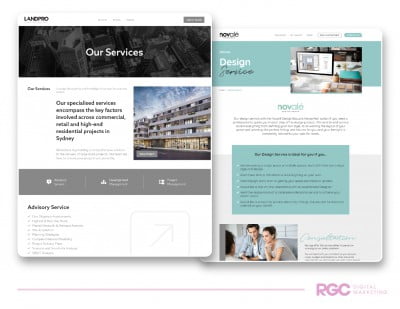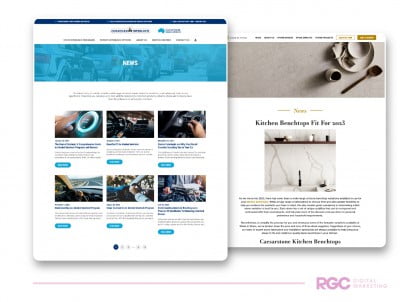How To Design A Scalable Website To Allow For Future Content

Quality web design is essential to the success of brands in the modern marketing landscape where user experience rules and top-quality content rule supreme. But how can you be sure to design a website that future content to be added without damaging the user experience and existing design? You’ll need a scalable website.
It’s not an easy task, because you never know how much text will be produced and which formatting it will require. That’s why scalability is a necessary consideration to ensure any new content for your website will fit seamlessly into your existing structure. The goal of adding extra content to your website should be to offer more value and information for your web visitors. Taking away from their user experience by mixing design styles and creating a complex navigation system is never ideal.
By planning ahead and designing your website with scalability in mind, you’ll ensure your website delivers a fantastic user experience in the short and long term. In our many years of operation, our team has designed a number of websites for smaller businesses in particular that require a scalable product for future expansion. We’ve shared some of the tips we’ve learned along the way to help you produce a scalable solution that won’t inhibit your future expansion.
So, What Is A Scalable Website?
When we refer to a scalable website, we’re discussing a website that has been designed to handle volumes of content and traffic above its current level without added costs or reduced performance. For this to become a reality, you’ll need to account for both technical scalability and content scalability.
As its name suggests, technical scalability considers the ability of your website to cope with extra users while maintaining consistent load speeds and performance. Correspondingly, content scalability looks at the ease with which new content can be added to your website without interrupting the existing design and navigation systems.
Both of these factors must be considered to design a future-proof website that will continue delivering a great user experience despite changes to the content and your web successes.

Why Does A Scalable Website Make Sense For You?
Now that you understand what scalability means for a website, you’re probably wondering whether you really need to implement it within your own website. In short, we recommend that you consider scalability as it can prevent your website from encountering many problems in the future.
Designing a scalable website is crucial because it makes sure your business doesn’t suffer from its own success. Hopefully, in time your website will garner a fantastic reputation and great popularity, seeing you experience a big increase in web traffic and engagement. However, if you’ve not considered technical scalability in the design phase before website development commenced, your website will simply have a limit to the number of users it can facilitate until its load speeds plummet and it eventually crashes.
Similarly, if you fail to account for content scalability in the design of your website, you’ll limit the amount of text your website can comfortably accommodate. As your business expands and you diversify the services you offer, you’ll want to be able to reflect this on your website. If you don’t create a design that can easily be expanded upon, the intuition of your navigation system will be compromised and you’ll hamper your user experience.
To avoid these problematic issues and promote increased traffic and customer satisfaction, be sure to follow these tips when you design your website. While this is not an exhaustive list and alternative options are available, these tips can form the basis of your website scalability efforts.
Scalability Considerations For New Content
If you’re looking to expand your business in the future and you’re likely to offer a wider range of products or services, your website will need to reflect this by offering more information in the future. In this case, it won’t be enough to create a website structure that offers an easily navigable interface and aesthetically pleasing design for only the content your website will initially feature. Instead, you’ll need to consider several visual and technical factors to ensure content can easily and conveniently be added to your website without any adverse impacts.
Simplicity Is Your Friend
If you’ve worked hard to create quality content, and you think you’ll invest in further content marketing services in the near future, it’s advisable to opt for a simpler layout. This doesn’t mean that you’re compromising on visual appeal. Instead, it means implementing a workable and fitting visual design that doesn’t have various complex layers that need to be considered each and every time new content is uploaded.
Limiting the number of elements on each page of content is a good place to start, as this minimises the need to continue designing several bespoke elements for each page. In a similar vein, consistency is key to ensuring each of your new pages of content can slot seamlessly into your existing structure. Content and design templates are a great way to achieve this, and when they’re customised to evoke your brand identity and best features, they make for a unique feel throughout the entirety of your scalable website.
In keeping with a simple, consistent and branded experience, it’s important not to overload your web design with masses of images. To cut down on the time that’s required to implement new content, consider the quality of your images rather than their quantity. Calling on your existing templates aids this process and prevents repetitive resizing and cropping, an arduous task that is better to be automated within a consistent design. Plus, reducing the number of elements on your web page will allow for quicker load speeds, one of the most crucial parts of a great user experience.

Opt For A Content Management System
Typically, the process of creating, editing, and managing your website content is particularly long and exhaustive, requiring great organisation. However, it’s best to opt for a content management system (CMS) that can offer exactly those services. These software applications, such as WordPress and Drupal, have become very commonly used within the industry, and they fast-track the process of uploading content.
With a user-friendly interface that eliminates the need to manually update page information, website administrators can easily update, delete and add new content when required. A CMS offers access to multiple users simultaneously, allowing for easier collaboration and task delegation as the scope of your website increases and swathes of content need to be managed. Importantly, the underlying code of the website does not need to be altered and specified permissions can be granted to ensure the security of your content.
Essentially, a CMS will vastly reduce the time and effort required to update new content on your website, making for a more streamlined process.
Make Use of Your Existing Structure
Sustainability is a crucial factor in designing a scalable website structure that can prove highly functional for many years to come. The best way to produce a sustainable structure is to consider the types of information that might need to be written, and attempt to categorise them. While you may have already planned to write about several different elements of your products or services, it’s important to consider whether they follow any patterns.
Quite often, businesses will believe they need to develop an entirely new category to accommodate their new information. However, this may not be necessary by including a “News” or “Blog” category within your initial structure which groups new updates your business would like to announce. This is a fantastic shortcut that we offer to many of our clients because it cuts down on their web design demands and also helps with any SEO efforts your business may invest in.
While a quality web design is important in promoting your brand, pairing these efforts with a top-class SEO strategy can give your website greater exposure, allowing your business to thrive. A common SEO strategy that makes use of a blog section is content writing, where keyword research and industry-specific information are summarised into blog posts that offer valuable information to address customer concerns. When these SEO strategies are carried out well, your business will benefit from higher search engine rankings. This connects your brand with more customers and helps your business encounter greater web traffic and ultimately increased sales, making your scalability efforts necessary.

Speed Is Crucial For Any Scalable Website
In designing a quality website that can handle new content, it’s important to keep its technical scalability in mind. Crucial to this process is choosing a fast web hosting provider. These providers allow for high web traffic, and a fast database ensures quick load times are maintained. When these services are combined, they’ll give your website the capacity it needs to offer all users a great experience.
High website traffic often comes at the expense of website performance, and this can have many negative effects. If your website doesn’t quickly retrieve relevant information and offer fast load speeds, your web visitors may not interact with your business. If customers aren’t able to access the information they need and cannot easily complete purchases, they simply won’t. Your website may face a series of technical issues that take time to fix, driving traffic away from your website.
To ensure your business consistently offers a quality user experience, speed and capacity must be central to your web design.


